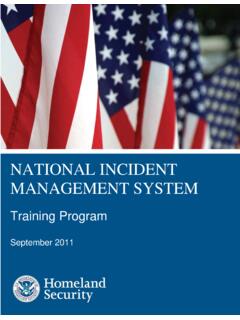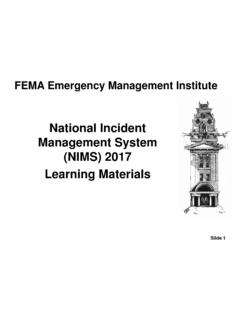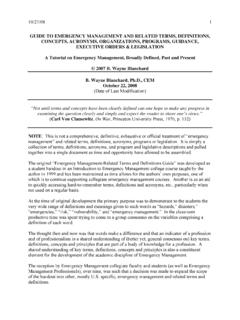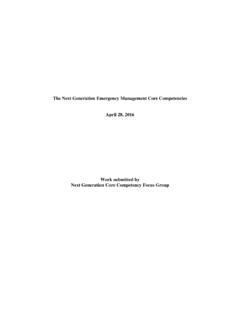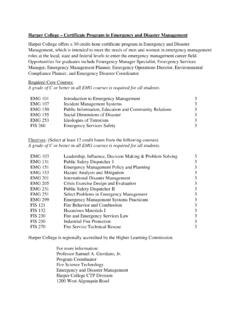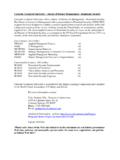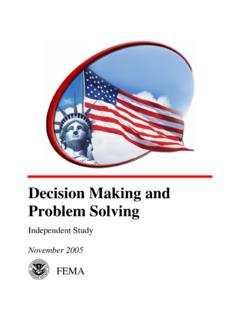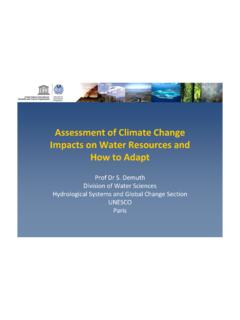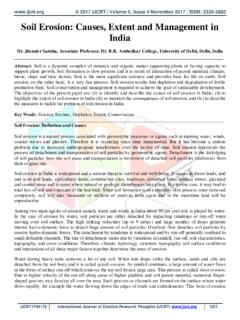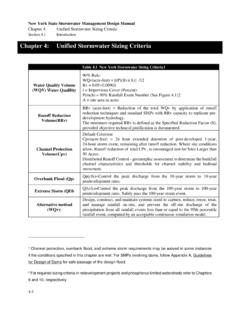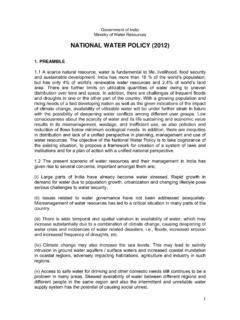Transcription of Chapter 2 Types of Floods and Floodplains
1 Types of Floods and Floodplains 2-1 Chapter 2 Types of Floods and Floodplains Chapter Overview There are several different Types of Floods . Most communities experience only a few of them. Floods are generally grouped into the following Types ; Riverine flooding Urban drainage Ground failures Fluctuating lake levels Coastal flooding and erosion Within some of these groups there are several subtypes of Floods . Surface Water Runoff When rainfall reaches the Earth s surface, water evaporates, infiltrates into the soil , or runs over the surface.
2 The kinds of ground cover greatly influence the proportions of each of these actions. In various Types of communities, and within communities, there are different cover Types . For example, an urban area, like a city, might have these cover Types : Open space (lawns, golf courses, parks) generally covered with grass Streets and roads Paved parking lots, shopping centers, Houses and residential areas Offices and business areas If the rainfall intensity exceeds the evaporation rate and infiltration capacity of the soil , surface runoff occurs.
3 It also occurs when rainfall falls on impervious surfaces, such as roadways and other paved areas. Water flows across the surface as either confined or unconfined flow. Unconfined flow moves in broad sheets of water often causing sheet erosion . It can also pick up and adsorb or carry contaminants from the surface. Water that flows along the surface may become trapped in depressions. Here water may either evaporate back into the air, infiltrate into the ground, or spill out of the depression as it fills. If local drainage conditions are inadequate to accommodate rainfall through a combination of evaporation, infiltration into the ground, and surface runoff, accumulation of water in certain areas may cause localized flooding problems.
4 Alternately, the sheet flow may reach a natural or constructed water conveyance system such as a swale, channel, or conduit. Water is conveyed to larger drainage systems such as creeks, streams and rivers. During winter and spring, accumulation of snow may increase water runoff generated by both precipitation and snowmelt. Flooding problems resulting from runoff of surface water generally increase as areas become more urbanized. Greater population density generally increases the amount of impervious area, , pavement and buildings.
5 This reduction in the amount of natural ground that can absorb rainfall results in an increase in the amount of surface runoff generated. Uncontrolled, this runoff may be channeled to areas that cause flooding of structures and roadways. This may be especially true Types of Floods and Floodplains 2-2 where the predevelopment land surface had a gently sloping surface with no defined channels. Such areas are subject to shallow sheet flooding during storms, but urbanization and other development speeds the accumulation of floodwater.
6 When surface water runoff introduced into streams and rivers exceeds the capacity of the natural or constructed channels to accommodate the flow, water overflows the stream banks, spilling out into adjacent low lying areas. Riverine flooding occurs as a consequence. Riverine Flooding The dynamics of riverine flooding vary with terrain. In relatively flat areas, land may stay covered with shallow, slow-moving floodwater for days or even weeks. In hilly and mountainous areas, Floods may come minutes after a heavy rain. The short notice, large depths, and high velocities of flash Floods make these Types of Floods particularly dangerous.
7 Among the common Types of riverine flooding are: Overbank Flooding Overbank flooding of rivers and streams the increase in volume of water within a river channel and the overflow of water from the channel onto the adjacent floodplain represents the classic flooding event that most people associate with the term flood. In fact, this is also the most common type of flood event. Hundreds of riverine Floods , great and small, occur annually in the United States. Photograph of water everywhere flooded subdivision. Riverine Floodplains range from narrow, confined channels (as in steep river valleys in hilly and mountainous areas) to wide, flat areas (as in much of the Midwest and in many coastal areas).
8 In the steep narrow valleys, flooding usually occurs quickly and is of short duration, but is likely to Types of Floods and Floodplains 2-3 be rapid and deep. In relatively flat Floodplains , areas may remain inundated for days or even weeks, but floodwaters are typically slow-moving and shallow. Photograph of mountainous floodplain. Along major rivers with very large drainage basins, the timing and elevations of flood peaks can be predicted far in advance and with considerable accuracy. In very small basins, flooding may be more difficult to predict to provide useful warning time.
9 Generally, the smaller the drainage basin, the more difficult it is to forecast the flood. Photograph of call to 911 to report flooding? Flooding in large rivers usually results from large-scale weather systems generating prolonged rainfall over wide areas. These same weather systems may cause flooding in hundreds of smaller basins that drain into the major river system. The streams and small rivers are also susceptible to flooding from more localized weather systems that cause intense rainfall over only a small area. In parts of the northern and western United States, annual spring Floods result from spring snowmelt and the extent of flooding is dependent upon winter snowpack and spring weather patterns.
10 Types of Floods and Floodplains 2-4 Several high-risk or unusual Types of riverine flooding are described in the following sections. There is often no sharp distinction between flash Floods , flooding due to structural failure or overtopping, flooding on alluvial fans, and the other Types of high-risk flooding described. There is much overlap among these Types of Floods that tend to represent different characteristics of the entire range of riverine flooding. However, the following categories are widely recognized and helpful in considering not only the range of flood risk but also appropriate responses to the risk.

